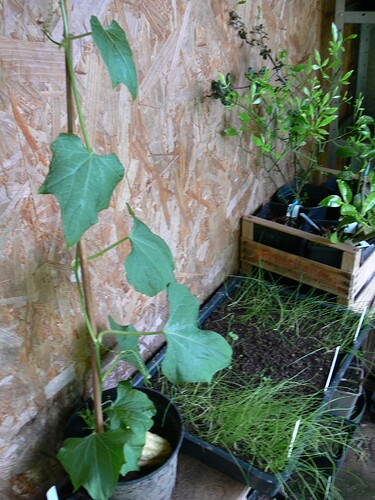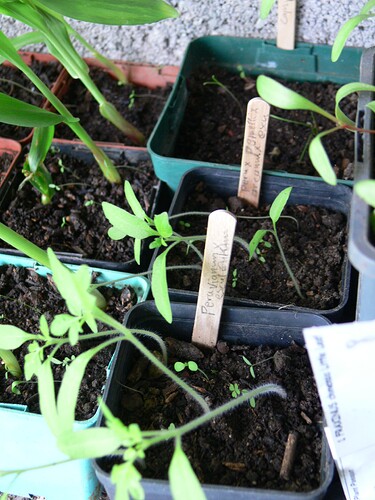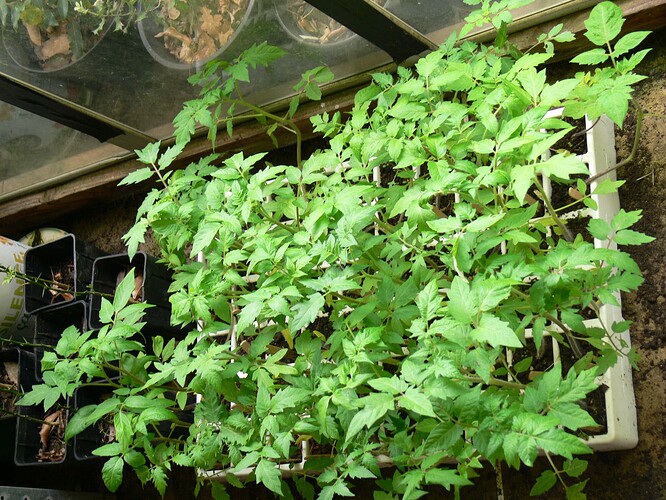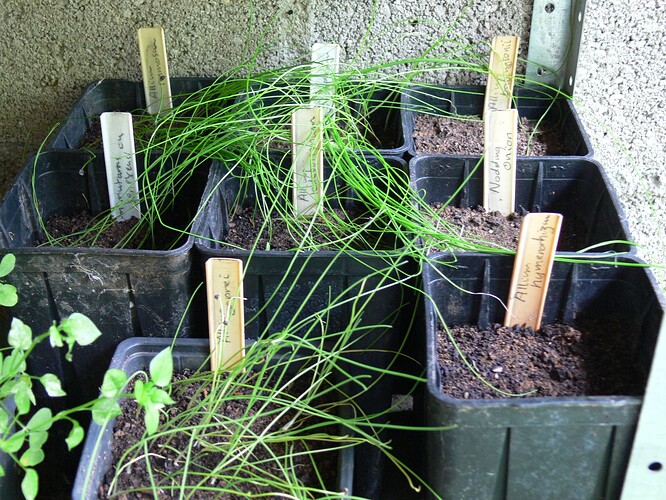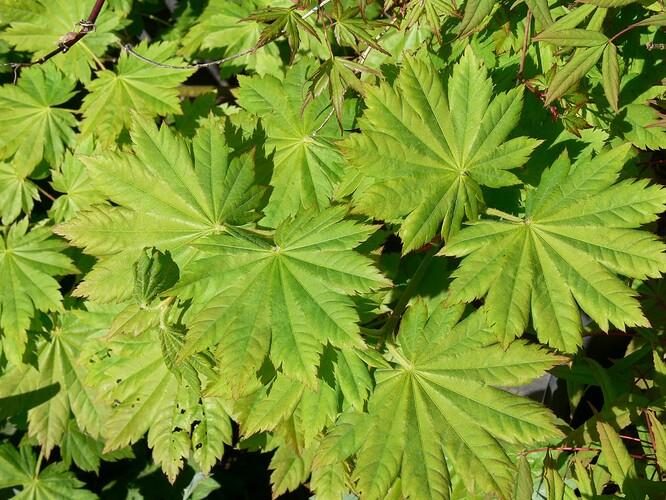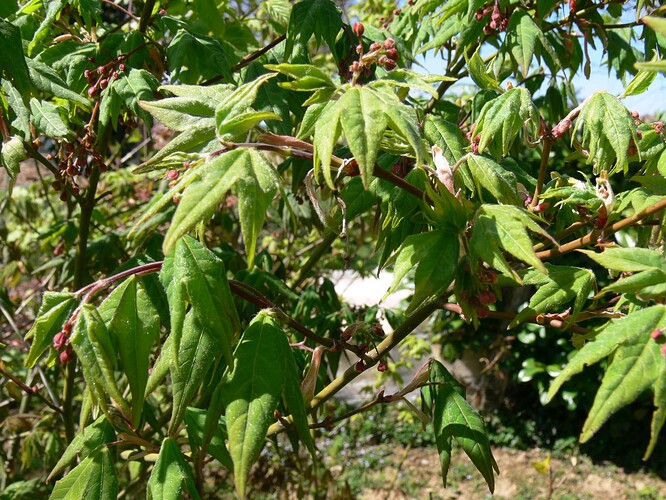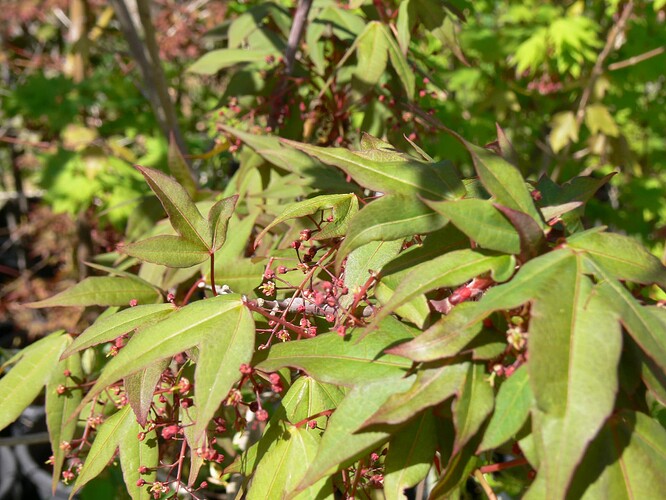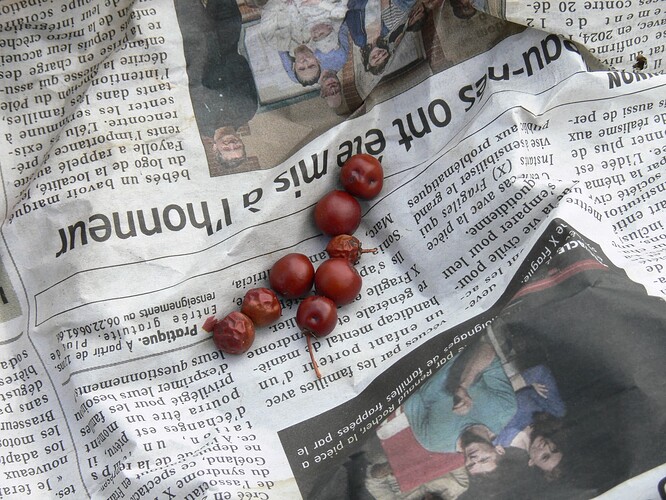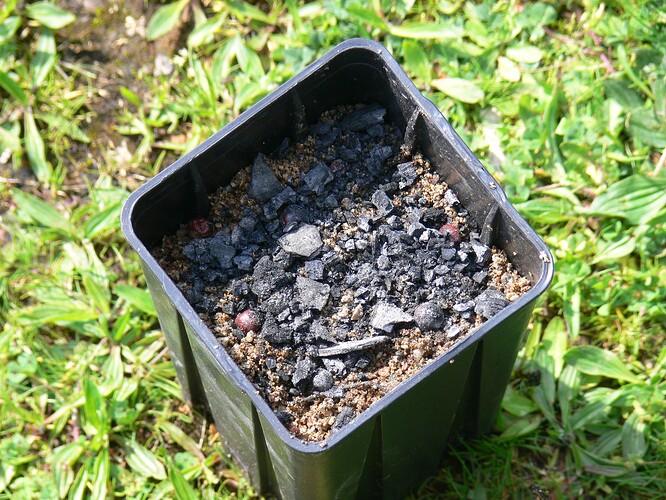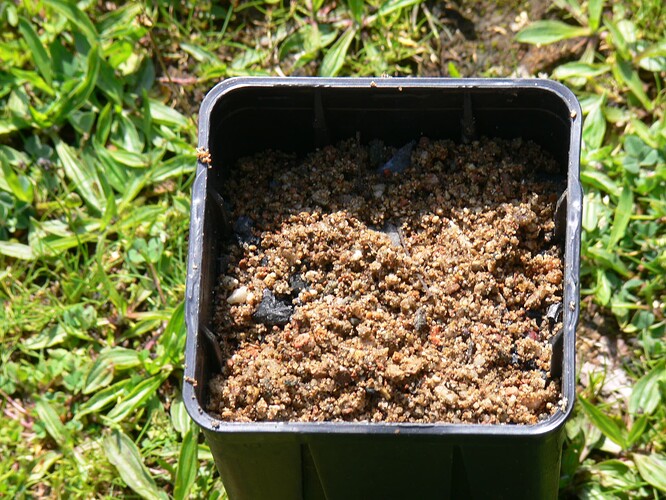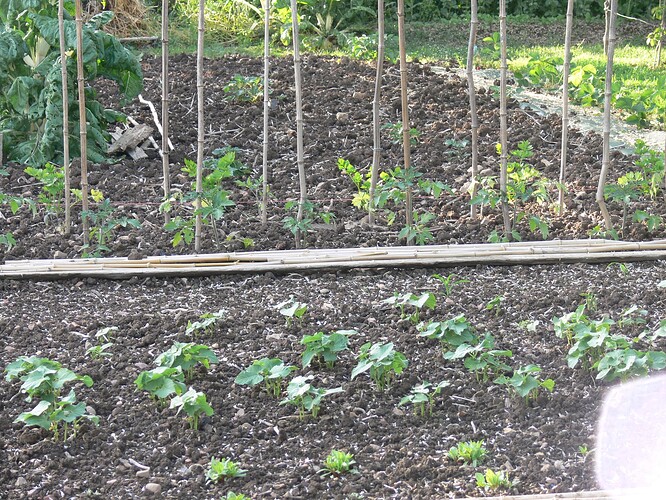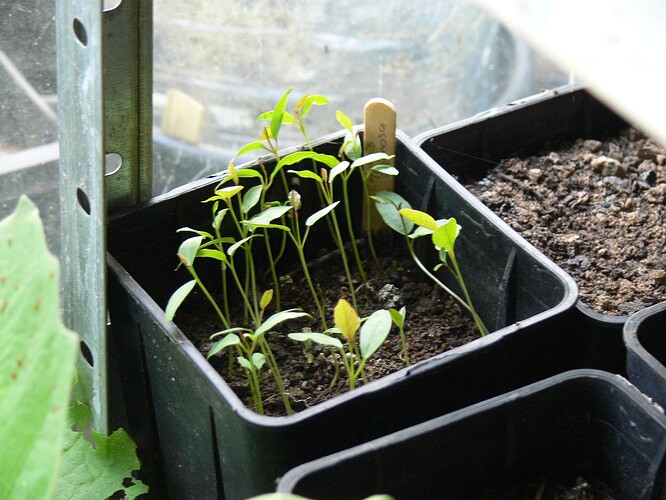with pleasure ! ![]()
Friday was with our local collective, our annual sale of young trees. For 5 years we have been committed to make a group order with a local nursery so that the inhabitants have access to quality young plants at reduced rates (2.8 €).
This also allows the association to have some profits to finance other actions.
My first wish when I started this project, was that all these new trees could maintain our natural heritage which suffers from the summer heat had many old trees dying.
The second one had a more symbolic value, which was to say we will plant 1 new tree for each inhabitant of this very vast rural territory (dozens of small villages) with 90,000 inhabitants. ![]()
![]()
however I hadn’t set a deadline to achieve such an outcome, and I intend to live as long as possible to get there ![]()
This year 761 new trees have joined our landscape. Wild trees, but some of which are quite rare in the region such as Sorbus torminalis and Sorbus domestica.
2020 : 928 trees
2021 : 1 313 trees
2022 : 674 trees
2023 : 1887 trees
2024 : 761 trees
with the results of previous years we have arrived at the figure of 5,563 trees in 5 years!
That is 10 times faster than I can do with my job in a city that has a lot of budget… the success of the ecological transition is therefore strongly linked to the sum of small actions actions that everyone does…
Let’s plant trees! ![]()
During our evening we also made a sale of our bread (82 kg!) but also flour (100 kg!) that we make from our wheat population.
After a little break related to the abundance of exchanges and orders of seeds to launch the season 2025, here I am back hard as Iron and sweet as love! ![]()
January was also an incredible time to grow the community. Here a recording I made for the local radio (radio Cactus) to make known the Adaptation Gardening spirit to other habitants of my rural territory.
This free, open-access podcast is shared with you here because I know that other francophone communities will be able to use it as a support to promote all the incredible work done by each of us here! ![]()
then… Going to this new season that will be stunning! ![]()
some seed collection of the population ‘Emerald Naked Seeded’ from EFN and growed in 2024 .
6 first TGS F1 garlic taken from the French genetics bank ! An exciting project you will hear about as it involves other GTS members ![]()
after a very hot week for the 18/20°C season, here is yesterday morning’s puny spectable…1°c with a day of snowfall…non sens, because tomorrow it is expected 15°C and return of sun ![]()
some nice raddichios, that will be the first seeds for a project of grex in progress.
new garlic production for 2025
new project of japanese Daikon grex
last leek to be harvested
the first fava bean germination…very late this year because I did not manage to sow in the fall but only 1 month ago
the rhubarb that returns just for the first snow of the year ![]()
in the cold greenhouse, the chayote coming from Majorca for this new test. Thanks to @Tanjaeskildsen
with maturing fruit of Citrus ‘Thomasville’ (complex rustic hybrid)
at left germination of leek grex @Hugo and @marcela_v and mine
on center future germination of celery stick rainbow grex (yellow, white, green, red and pink form)
at right germination of perennial leek Bendigo Bitza from @gregg_muller Australia ! the climate change is assured for them ![]()
with this winter weather what could be nicer than receiving a GTS buddy for a good meal and a seed festival. Thank you for stopping @ThomasPicard during his intergalactic tour !
huge quantities and bags of seeds on the table ! ![]()
![]()
![]()
in the nursery, first collection of the most rustic varieties of olive trees in france. They come from mountain areas, or the most northern area…
Selection criterion resistant to -15°C and more.
We must launch an olive orchard in the coming years, to make our own oil in the Brionnais! project a bit crazy but still very stimulating ![]()
I love it all😍 What sn exiting season ahead!
I am looking forward to see how the olive project will develop. I planted many olive seeds into the ground as well ![]()
it’s a longer-term project with the trees, but I hope we’ll have the opportunity to let you taste organic olive oil from Brionnais in 15 years’ time ! ![]()
If anyone in the group knows of any hardy varieties (that come from high mountain areas, or geographical areas far to the north) in their own country, I’d love to have the information, or even better some cuttings ! ![]()
Stephane, I would recommend you reach out and touch base with the ‘One Green World’ nursery folks in Portland, Oregon. They are very friendly folks and they have a decent olive section in that nursery and are really pushing them North of Cali in a concerted effort. They do a lot of work with that pseudo-hardy Mediterranean type plant population as well working explicitly with analogs from the mid highlands of South America (if I recall off the top of my head, they target plant analogs from the highlands of Argentina. Lots of interesting pineapple guava, for example). Here’s ‘One Green World’s’ Olive page: See specimens HERE. And, as another recommendation, the folks at ‘Cistus Nursery’ on Sauvie Island north of Portland in the Willamette River as it travels to meet the Columbia. They were always extremely willing to discuss all things hardy in climate parallels. I remember discussing several olives they considered worthy of trying in zone 7 areas. I no longer live in Oregon and I certainly have no ability to even fathom growing olives here. BUT, it may be worth your time talking with their nursery folk and simply giving them a message to see what comes of it.
One last thing here, I reached out to my besty - an absurdly amazing botanist and general plant wizard in Corbett, Oregon. He semi-regularly
visits his ancestral lands within the Istrian peninsula as he still has family there. He had this to say: (I’ll keep this in mind and see if I can’t get him to send me said cuttings and I’ll send them your way)
I have 10 rooted cuttings of Buza an Istrian northern variety that I’ve just started. In a couple of years I’ll have enough plant material to make more!
.
thank you very much Joseph for your contacts and for telling at your friend botanist. ![]()
One green world and Cistus are on the same latitudes as where I live. So they probably have the same problems with the cold some winters.
The former have a good collection of unusual olive trees, and I’m going to contact them to discuss their provenance of varieties that surprisingly arrive from work at the Yalta botanical garden in Ukraine.
As for Cistus nursery, I’ve been following their work for a long time; they have a very, very interesting range of plants, and even make hybridizations, notably of the Mahonia genus.
Yeah, I used to live and farm on Sauvie Island. Hilariously, I mostly used their nursery to take away their discarded pots and use them myself. LOL. But, to your point: an incredible array of stateside Mediterranean plants. Let me know if you need any assistance in your quest my way. I have ample means of contacting and requesting from folks. If need be, I could very easily have materials sent here and I could send them to you if there are any hold-ups or hesitancies for whatever reasons. Happy to help anyone and everyone trying to push the extremes in their locales. I essentially farm on Mars so am doing that with nearly everything I do outdoors. ![]()
On Friday evening, I gave another presentation on adaptive gardening to a local garden club. Over 20 people turned out to discover the new possibilities for the garden.
I talked during 1h30 about human/plant coevolution, the transfer of seed production from farmers to firms, seed types (F1, GMO, heirloom, population varieties…) and the methodology for starting a grex and then a landrace.
Everyone was delighted with the photos of productions and successes that each of us can display here. ![]() (thank to everybody)
(thank to everybody)
New arguments have been successfully tested, such as “plant incest” in relation to the reproduction of pure varieties ![]() (thank you to @marcela_v), and also that the local varieties they can create while old will be a blessing in Inheritance to the following generations, and that this may put them on a path to immortality
(thank you to @marcela_v), and also that the local varieties they can create while old will be a blessing in Inheritance to the following generations, and that this may put them on a path to immortality ![]() .
.
Some of them were completely hooked, and told me that from this weekend onwards, they would be tackling sowing with other methodologies and prospects for 2025. ![]()
congratulations Stephane and thank you for the good you are doing. I am impressed by the ability several members of this community have to hold a 1h30 long speech on the subject in front of a seated audience. I mean I could speak for hours, but just in small groups and based on a questions / answers type of process.
WELL DONE !
Excellent Stephane! Where was this? Brionnais or your home town?
You seem to be on a road to perfectionize your presentation. Could it be filmed some next time?
it was in Charolles, the city of the breed of meat cow “la Charolaise”. I spoke of this anecdote of landrace by showing the photo of your neighbor who crosses meatcows. ![]()
@isabelle In order to talk as long, I have a slide show support with 80 slides. This images a lot the words, and above all allows to keep the thread although every time the explanations are not exactly the same depending on the level of gardening of the spectators. Of course I leave time for questions -answers that allow to see where the subject is less easy to understand. ![]()
I hope you told em off those folk breeding this ridiculous cow , too big calves to be born naturally and bad bad mothering. What a way to bankrupt a farmer.
I literally five minutes ago send those pictures to Marcela who is in Brussel on a farmer convention.
How do we interpret diversity?
2 years ago, while collecting wild garlic in the woods (allium ursinum), in a bed of millions of leaves, a plant caught my eye. A variegated plant, with lovely, clean white mottling.
Why did nature produce this thing…certainly a genetic writing error…a bug…
Horticulture has long taken care to reproduce these mistakes for their beauty, which is why I’ve Irresistibly collected this unique plant.
I placed it in a pot with the aim of multiplying it, but it seems that all its offspring are perfectly green (the leaves next to it). So I desperately try to multiply this mistake without success, which makes this plant even more unique. ![]()
So let’s have the same look of beauty with all those people who have 6 fingers, depigmented skin or a problem that prevents them from walking for life… ![]()
the super corn of Peru recovered in Antibes by @Hugo ![]() , were sown 15 days ago in a greenhouse. As they are very late varieties I have to accelerate them before planting them in the garden. I will try to pollinate Painted Moutain + @marcela_v grex with this if I can synchronize some blooming. Otherwise the pollen will be frozen for next year.
, were sown 15 days ago in a greenhouse. As they are very late varieties I have to accelerate them before planting them in the garden. I will try to pollinate Painted Moutain + @marcela_v grex with this if I can synchronize some blooming. Otherwise the pollen will be frozen for next year.
Chayote from @Tanjaeskildsen enjoys the pot shoot in the greenhouse where it has been 35°C for a week. It will be planted in the garden in 15 days once the cold nights are gone.
Great tomato hybrids from @ThomasPicard !
peruvianum x lycopersicum
peruvianum x pennelli x arcanum x lycopersicum
I will try to cross this with Island sunrise (solanum cheesmanii x solanum pimpinellifolium x solanum lycopersicum) from Smallislandseedco to optain a tomato with 6 wild genetic on the same plant
This year’s consumption tomatoes sow late and transplanted into plates. Each cell is a different variety.
Some species of wild garlic from @malterod sow this spring.
Tagetes lemmonii, perennial tagetes recovered following the exchange of tree enthusiasts. This edible species with flavors between mint and passion fruit, comes from the south USA/ Mexico and loves hot and dry. We will experiment in cooking this summer.
preparation of bean seedlings. The bush bean grex consists of 77 different genetics this year thanks to all the exchanges this winter.
The pole bean grex consists of 43 different genetics this year.
This family photos that will allow to compare with the harvest and look for new strains because there are already some F1 in this herd.
The TGS still growing in an old vineyard land. Out of the French genetic bank this winter, they seem not vigorous.3 of the 6 varieties are really in trouble and not sure to be saved with few plant (MX 4 x J 203, AS 01 13 1, AS 01 5 6). Is it the same with you @Joran and @marcela_v ?
in Nursery, is madness in rare Palmata maples species with Acer takesimense
Acer robustum
Acer oliverianum
Acer campbelli ssp. flabellatum
Acer circinatum x palmatum
Acer tutcheri
Acer cordatum
Acer sieboldianum
All these yet very varied species form with others my grex for crossing experiments. The objective will be to find new forms of leaves, and plants more resistant to verticilium (soil disease whose Japanese maples are sensitive). adaptive plants for horticulture of tomorrow ![]() .
.
Arctotaphylos are also tested, as they are the hardest plants to germinate and grow here.
So let us be inspired by the process of nature that takes place after a fire in the west and south of the USA.
fruits put in a paper and burned quickly
They then grow in poor and very draining land. I put a leaf soil + very acidic sand…then put the burnt fruits on pure sand.
Add some crushed charcoal that could release some fire substance and avoid cryptogamic diseases on susceptible species.
another sand
and another substrate…
Let’s see if these perfect conditions and experimental seedling can finally germinate these capricious plants ![]() .
.
Here are very rare seeds of Arctotaphylos pungens collected in New Mexico and Arctotaphylos pringlei collected in Arizona by a botanist friend.
If you live in these areas and know the cultivation of these plants, please contact me because I have many questions about their biotope. ![]()
Arctotaphylos manzanita
A plant that I had bought in the nursery but here it is impossible to find because no one understands this family of trees which are nevertheless beautiful and ultra resilient with regard to their biotopes. Let’s find a way to plant them in the gardens.
the first peas in the garden and on the plate! this year I will landrace Lokförare Bergfälts Jätteärt, this giant pea that I would like to see with new colors.
fava beans almost ready to eat
news grex with new flower colors
the potatoes are well this year even if the climate alternates every 10 days between winter and summer, without going through the spring.
Chayote from @Tanjaeskildsen who climbs quickly outside even if sometimes we still have cold nights with 5°c. This variety seems hyper resistant
tomatoes that do not grow too much with this rotten weather
some sprouting of beans
daikon radish grex version 1. This fall it will be increased by the grex of @Tanjaeskildsen
Very happy that this guy has arrived in the field. Carabus auratus is a super predator of snails, slugs, and other vermin who eat vegetables.
new sprouting of Chilopsis linearis, seeds from Organ Montain New Mexico
new sproutinf of Caparis spinosa, seeds collected by me in Ischia Island Italy last fall during our vacation with my wife. I am eager to experiment with the production of capers in Burgundy. They will probably have to be planted out of the ground, in the stones walls facing south as I saw it grow there. This plant seems so resistant to extreme temperatures and drought.
Wow, fantastic update Stéphane! ![]()
Still wrapping my head round your plans to freeze corn pollen. Have you done it before?

























